 |
 |
TESTING OF A NEW SURVEY TECHNIQUE
Chris Evans and Bryan Henderson
 |
 |
 |
Abstract: Scent stations are a valuable technique for assessing abundance of carnivore populations. The traditional method of scent station surveys involves techniques that are time consuming and affected by environmental factors. The improved version of a scent station is more time conservative and protects the data from adverse conditions. The improved version has been shown to be effective on rodents. We tested to see if the improved scent station would be as effective as the traditional scent station for medium-sized mammals. We compared catch per unit effort on eight traditional scent stations and eight improved scent stations over 238 trap nights. A significant difference was found between the catch per unit efforts using a t-test. The catch per unit effort on the improved version was significantly less than the traditional version. Although the catch per unit effort varied, we still recommend the use of the improved version for certain situations. | ||||
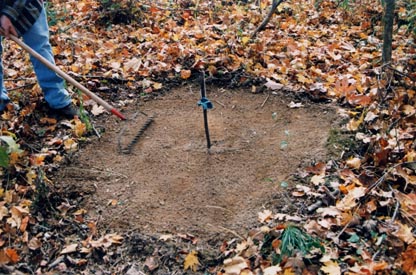 |
BEAVER FORAGING BEHAVIOR AT FERGUSON SPRINGS
Adam Smith and Matt Walker
 |
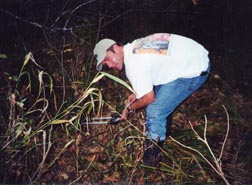 |
 |
Abstract: The foraging behavior of beavers at Ferguson Springs in Land Between the Lakes, Kentucky, was examined based on a central place feeding model of optimal foraging. Hypotheses involving multiple parameters were tested including: tree selection based on size and distance from shoreline, and tree selection as a function of tree availability. Four random transects (45m long, 5m wide) were used for data collection. Each transect was divided into three distance categories for data analysis as a function of distance from shoreline. Data analysis indicated that uncut trees had significantly larger diameters than cut trees and that cut tree diameters was independent of distance to water; while uncut tree diameters showed a significantly increasing correlation. Beaver selectivity apparently increases with distance from water, and beavers tended to select trees based on availability. The results indicate that the beavers of Ferguson Springs exhibit some but not all characteristics of the typical central place forager. |
RESPONSE OF WHITE-FOOTED MOUSE (PEROMYSCUS LEUCOPUS) AND DEER MOUSE (PEROMYSCUS MANICULATUS) TO HABITAT FRAGMENTATION CAUSED BY URBANIZATION AND AGRICULTURE
Rebecca E. Brown and Nicholas S. Murray
 |
Abstract: We studied population size of Peromyscus sp. (P. leucopus and P. maniculatus) in two types of habitat disturbance: urbanization and agriculture. We placed 25 standard Sherman livetraps on a forested stream edge that was fragmented by urbanization and 25 standard Sherman livetraps on a forested stream edge that was fragmented by agriculture. Both trapping sties were along Bee creek in Murray, Kentucky, and were separated by Bailey road. We trapped both sites simultaneously during four trapping periods in November. We marked Peromyscus sp. with ear tags and used the Lincoln-Peterson population estimate statistic. We found a population of 4.3 Peromyscus sp. inhabiting the site disturbed by urbanization compared to a population of 30.0 Peromyscus sp. inhabiting the site disturbed by agriculture. From our data, we believe that areas disturbed by urbanization will have lower populations of peromyscus sp. than areas disturbed by agriculture. It is fact that all habitat disturbances affect small mammal populations, but some are less detrimental than others. |
SELECTION OF TREES FOR NEST SITES BY THE
EASTERN GREY SQUIRREL (SCIURUS CAROLINENSIS) AND EASTERN
FOX SQUIRREL (SCIURUS NIGER)
Grant Dunning and Martin Wheeldon
 |
 |
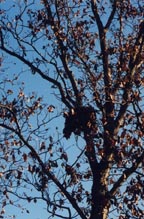 |
Abstract: This project focused on the nesting preferences of the Eastern Grey Squirrel (Sciurus carolinensis) and Eastern Fox Squirrel (Sciurus niger). Squirrels use den trees as well as leaf nests. Den trees are year round sites, whereas leaf nests are more temporary shelters. We tested to see if squirrels selected for mast trees over non-mast trees, as sites for leaf nests, across habitats where abundance of mast trees was significantly different. Our results showed that squirrels do preferentially select for mast trees where available. Using a z-test, we rejected our null hypothesis that there is no selection for mast trees as opposed to non-mast trees. We recorded 74% of leaf nests, across all sites, to be in mast trees. This is significantly greater than 40.6%, the expected value according to tree species account. Using these results, we can better understand what types of trees squirrels choose for leaf nests. We would expect populations of squirrels to fluctuate with the abundance and crop production of these mast trees. |
PARELAPHOSTRONGYLUS TENUIS (BRAINWORM)
Michael Elsea and Mary Ellen Prince
 |
Abstract: The occurrence of Parelaphostrongylus tenuis in white-tailed deer (Odocoileus virginianus) and elk (Cervus elaphus) was examined in the Tennessee Valley Authority's (TVA) Land Between the Lakes (LBL). Our hypothesis was that there was a correlation between the frequency of occurrence of P. tenuis in the two cervids. Fifteen fecal samples from white-tailed deer and elk were collected and examined for P. tenuis using a modified baermann technique. The meningeal worms were identified by morphology provided by Anderson and Prestwood (1981). Results of our study showed 19.3 larvae/g in white-tailed deer, but 0 larvae/g in elk. Our study showed no correlation between the occurrence of P. tenuis in deer and that of elk. Further research could be done on this topic to ensure the health and well being of future reintroduced elk to areas where there are high densities of white-tailed deer. |
PHENOTYPIC DIFFERENCES BETWEEN AN ISLAND POPULATION OF MARSH RICE RAT WITHIN KENTUCKY LAKE AND THREE MAINLAND COUNTERPARTS
Alan Whited and Jeremy Bennett
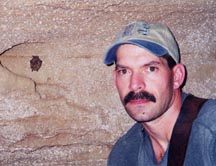 |
 |
Abstract: We trapped an island within Kentucky Lake to
determine if small mammals inhabited the island, which has never been documented
before. March rice rats (Oryzomys palustris) were captured
and used to determine if phenotypic variation occurred between island populations
of rice rats and their mainland counterparts. The standard measurements
of total length, tail length, hindfoot length, ear length, and weight were
recorded for nine island rats and six mainland rats. We used a student's
t-test to determine if there was a significant difference in morphological
phenotypes between the island population and the mainland population.
There was a significant difference in total length, tail length, and ear
length, but not in hindfoot length or weight between populations, with
mainland populations showing an overall larger size. We acknowledge
the fact of a small sample size (n=14), but suggest that phenotypic variation
may occur between island species of O. palustris and their mainland
counterparts as suggested by past small mammal/island studies.
THE RELATIONSHIP BETWEEN DISTURBANCE AND FREQUENCY OF SMALL MAMMAL
SPECIES
IN BOTTLES ALONG HIGHWAYS
Rhonda Finch and Karen Peluso
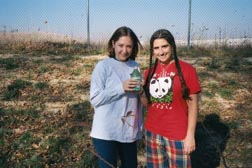 |
 |
Abstract: Along the highways surrounding Murray, Kentucky 11 sites were randomly selected to determine the relationship between the occurrences of small mammals species in bottles and the amount of disturbance in the area. The alternate hypothesis states that the frequency of species occurrence increases in sites of high traffic frequency, high traffic, amount of garbage, and depth of vegetation. The results of our study did not fully support the hypothesis. We found that the amount of garbage was the only factor that significantly affected the frequency of species occurrence. A low amount of trash was significantly related to high levels of species occurrence. Our study found that the disturbance in the area does have a significant effect on the species occurrence of small mammals in bottles. |
DISTANCE FROM COVER, FOOD QUALITY AND PREDATION:
AN OPTIMAL FORAGING STUDY IN RACCOONS (PROCYON LOTOR)
Amyann Madara
Abstract: Are raccoons (Procyon lotor) affected by the distance that they must travel from cover, therefore exposing themselves longer to predators, in order to forage optimally? The study site was located at the edge of a deciduous treeline and a winter wheat field in early November, and was run for 10 consecutive days. Raccoons were given a choice of corn, a low quality food, and walnuts, a relatively high quality food. Food was placed on boards at given distances from cover and systematically placed over a 350 meter squared area. The type of food was placed randomly, but always consisted of 16 walnut boards and 16 corn boards, totaling 32. After analyzing the data, conflicting results occurred. The raccoons did forage optimally, consuming mostly walnuts, but distance may not play a role in foraging habits. The results partially suggest that raccoons may not follow the optimal foraging model.
THE RELATIONSHIP BETWEEN FLUCTUATING ASYMMETRY AND SEX
IN SKULLS OF NORWAY RATS (RATTUS NORVEGICUS)
Chi-lin Wu
Abstract: Fluctuating asymmetry in the numbers of nerve foramina in the skull is a very interesting topic. The nerve foramina can be used to understand the degree of asymmetry. I studied 19 Norway rats (Rattus norvegicus), using five different characters of the skull. These were the foramen frontale, foramen maxillare a, foramen maxillare b, and foramen mentale a and foramen mentale b on both the right and lift side of the skull. I counted the number of foramen to determine whether the skulls were asymmetrical or not. The degree of asymmetry between males and females was different, especially in the foramen maxillare a. These results do not completely confirm a relationship between sex and different foramina but do describe an asymmetrical condition in rodents. Why do males have a higher degree of asymmetry than females? It is not clear and needs further study.
THE EFFECTS OF CIRCADIAN RHYTHMS ON THE FEEDING HABITS
OF MALE AND FEMALE WHITE MICE (MUS DOMESTICUS)
Emily Helton and Julie Wolfe
Abstract: Many aspects of an animal's life are affected by circadian rhythms. Our hypothesis was that a change in light phases alters the animal's circadian rhythm, and affects the animal's eating habits. Twenty white mice (Mus domesticus) were housed in two rooms with controlled light phases. One room had 23 hours of light and one hour of dark, and the other room had 14 hours of light and 10 hours of dark. The effect of the two cycles on the different sexes was observed. Each room had 10 mice, five of each sex. The food consumed was measured daily. The mice with the longer dark phase consumed more than the mice with the shorter light phase. In the room with the shorter dark phase the males ate 7 percent less while the females ate 3 percent less. Our hypothesis was supported. Alteration of an animal's light phases will alter its feeding habits. It would be interesting to see if light phase shifts would affects humans the same way. Do graveyard shift workers eat more than the rest of us?